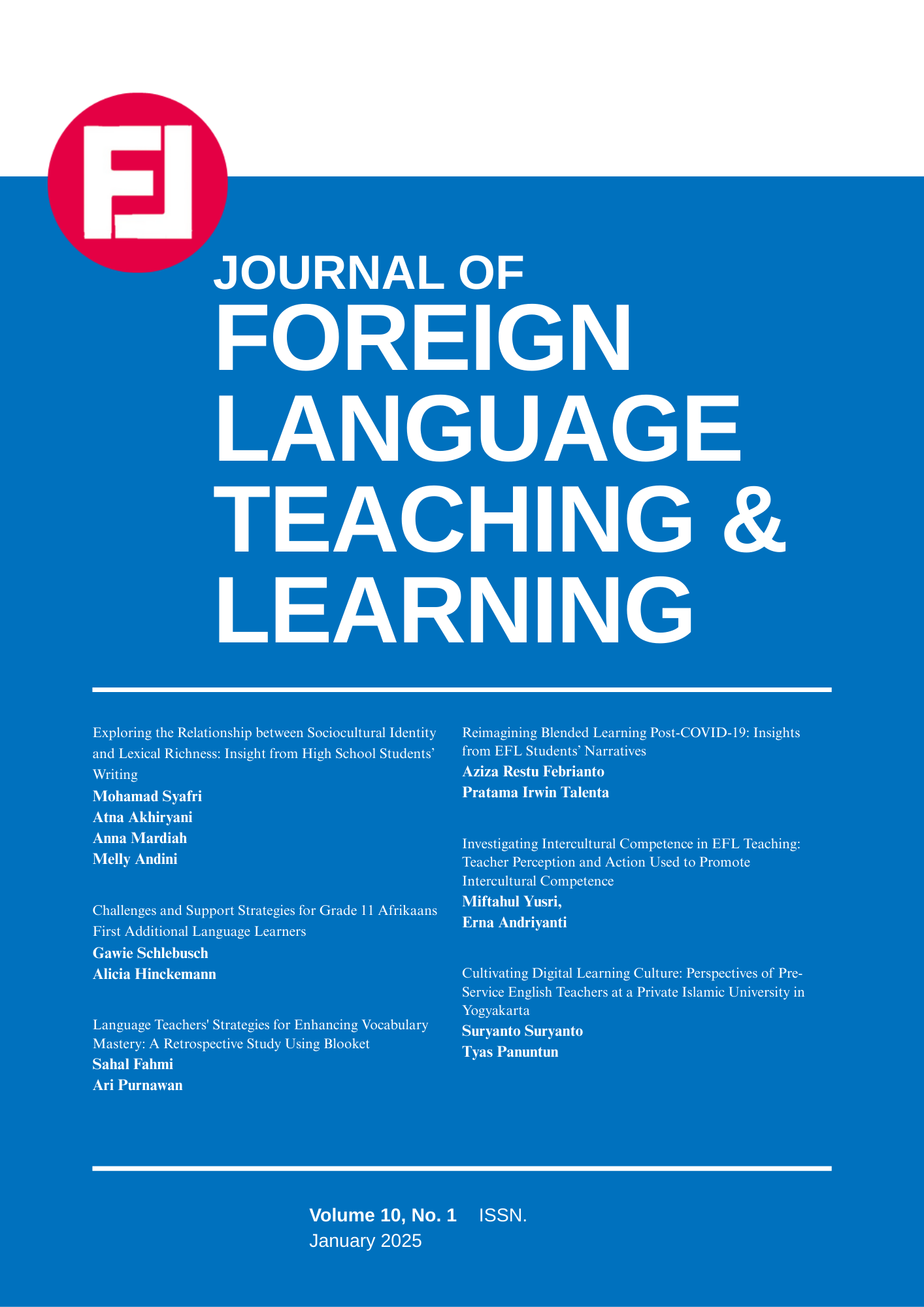Exploring the Relationship between Sociocultural Identity and Lexical Richness: Insight from High School Students’ Writing
DOI:
https://doi.org/10.18196/ftl.v10i1.24966Keywords:
Lexical Richness, Sociocultural, WritingAbstract
Background: Many variables, including culture and social conditions, bind language. The study of cultural aspects and language learning still has many gaps, such as exploring writing skills. Writing is considered a productive language skill that correlates with how students express and understand their circumstances and environments.
Objective: Therefore, this research explores sociocultural identity with Lexical Richness in text writing.
Methods: This research was conducted using a quantitative method. The research design is correlational analysis. The research participants were 86 eleventh grade students selected by purposive random sampling. The results showed that the significance value was 0.575, so it was concluded that there was no significant relationship between sociocultural identity and lexical richness in writing.
Findings: In addition, the research also found a high gap among students in expressing ideas with diverse words, where the range between the most and least varied text was 47% and the average 56.9%. It is hypothesized that the students' basic ability to use English will be a crucial indicator that influences competence before other external factors, such as their cultural background interference. In addition, this research can serve as a basis for future studies, especially considering that external factors in learning can play a role depending on prerequisite conditions.
Conclusion: For teachers and educators, this research could give insight into a more applicable way to develop vocabulary and writing.
References
Akmal, S., Fauza, N., Chamisah, & Syahabuddin, K. (2023). Classifying “culture” in Indonesian secondary public education EFL textbooks. Indonesian Journal of English Education, 10(1), 83–105. https://doi.org/10.15408/ijee.v10i1.29924
Aldawood, A. A., & Almeshari, F. (2019). Effects of learning culture on English-language learning for Saudi EFL students. Arab World English Journal, 10(3), 330–343. https://doi.org/https://dx.doi.org/10.24093/awej/vol10no3.23
Allagui, B., & Naqbi, S. Al. (2024). The contribution of vocabulary knowledge to summary writing quality: Vocabulary size and lexical richness. Tesl-Ej, 28(1), 1–27. https://doi.org/10.55593/ej.28109a5
Altugan, A. S. (2015). The relationship between cultural identity and learning. 5th World Conference on Learning, Teaching and Educational Leadership 2014, 186, 1159–1162. https://doi.org/10.1016/j.sbspro.2015.04.161
Annisa, N., Mirizon, S., & Silvhiany, S. (2023). Vocational high school students’ identity and investment in learning English in a rural area. Studies in English Language and Education, 10(2), 926–942. https://doi.org/10.24815/siele.v10i2.27167
Arum, E. R., & Winarti, W. (2019). The use of antconc in providing lexical and sintactical information of the texbook of radiographic positioning and related anatomy: A corpus linguistic study. Jurnal Sosioteknologi, 18(1), 106–112. https://doi.org/10.5614/sostek.itbj.2019.18.1.8
Astridya, F. W. (2018). Lexical richness of the expository writing in Indonesian senior high school students. Lingual: Journal of Language and Culture, 5(1), 23. https://doi.org/10.24843/ljlc.2018.v05.i01.p04
Ayadi, M. (2023). Lexical richness and syntactic complexity as predictors of academic writing performance. Journal of English Studies in Arabia Felix, 2(1), 23–33. https://doi.org/10.56540/jesaf.v2i1.43
Bakhtin, M. M. (2004). Dialogic origin and dialogic pedagogy of grammar: Stylistics in teaching Russian language in secondary school. Journal of Russian & East European Psychology, 42(6), 12–49. https://doi.org/10.1080/10610405.2004.11059233
Byram, M., & Wagner, M. (2018). Making a difference: Language teaching for intercultural and international dialogue. Foreign Language Annals, 51(1), 1–12. https://doi.org/10.1111/flan.12319
Castanelli, D. (2023). Sociocultural learning theory and assessment for learning. Medical Education, 57(5), 382–384. https://doi.org/10.1111/medu.15028
Cheek, J. M., Smith, S., & Tropp, L. R. (2002). Relational identity orientation: A fourth scale for the AIQ (Aspects of Identity Questionnaire ). Relational Identity Orientation: A Fourth Scale for the AIQ (Aspects of Identity Questionnaire ), April. https://doi.org/10.13140/2.1.1643.7763
Cheek, J. M., Tropp, L. R., Chen, L. C., & Underwood, M. K. (1994). Identity orientations: Personal, social, and collective aspects of identity. Annual Meeting of the American Psychological Association, August 1994. http://academics.wellesley.edu/Psychology/Cheek/aiq_iii.html
Corral-Robles, S., Madrid, D., & Gonzalez-Gijon, G. (2017). Cultural diversity and its implications for second language writing. The International Journal of Diversity in Education, 48(24), 399–399. https://doi.org/10.1177/002205749804802402
Creswell, J. W. (2014). Research Design: Qualitative, Quantitative, and Mixed Methods Approaches (4th ed.). Sage Publication, Inc.
Floranti, A. D., & Adiantika, H. N. (2019). Grammatical error performances in Indonesia EFL learners’ writing. Indonesian Journal of English Language Teaching and Applied Linguistics, 3(2), 277–295.
Halim, S. W. (2018). Lexical richness in English language and culture department students’ undergraduate theses. Journal of English Language and Culture, 8(2), 140–151. https://doi.org/10.30813/jelc.v8i2.1098
Han, J., & Hiver, P. (2018). Genre-based L2 writing instruction and writing-specific psychological factors: The dynamics of change. Journal of Second Language Writing, 40(November 2017), 44–59. https://doi.org/10.1016/j.jslw.2018.03.001
Hernández Castro, O., & Samacá Bohórquez, Y. (2011). A study of EFL students’ interpretations of cultural aspects in foreign language learning. Colombian Applied Linguistics Journal, 8, 38. https://doi.org/10.14483/22487085.171
Holmes, J. (2013). An introduction to sociolinguistics. In G. Leech & M. Short (Eds.), Language (4th Edition, Vol. 70, Issue 3). Routledge. https://doi.org/10.2307/416511
Hossain, M. Z., & Samin, A. M. (2022). Analysis of male and female speakers’ word choices in public speeches. Arxiv, 2001. https://arxiv.org/abs/2211.06366v1
Indarti, D. (2021). Lexical richness of students’ writings. Wanastra: Jurnal Bahasa Dan Sastra, 13(1), 47–53. https://doi.org/10.31294/w.v13i1.9683
Iswari, W. P., Suhatmady, B., Asih, Y. U., Wardani, I., Ramadhan, A., & Anastasya, D. (2021). Using concordance software to generate academic words in applied linguistics. Educational Studies: Conference Series, 1(1), 31–41. https://doi.org/10.30872/escs.v1i1.882
Jiang, W. (2000). The relationship between culture and language. ELT Journal, 54(4), 328–334. http://eltj.oxfordjournals.org/
Juanggo, W. (2018). Investigating lexical diversity and lexical sophistication of productive vocabulary in the written discourse of Indonesian EFL learners. Indonesian Journal of Applied Linguistics, 8(1), 38–48. https://doi.org/10.17509/ijal.v8i1.11462
Karlik, M. (2023). Exploring the impact of culture on language learning: How understanding cultural context and values can deepen language acquisition. International Journal of Language, Linguistics, Literature and Culture, 2(5), 5–11. https://doi.org/10.1075/ijolc.1.1.00edi
Kim, D. (2020). Learning language, learning culture: Teaching language to the whole student. ECNU Review of Education, 3(3), 519–541. https://doi.org/10.1177/2096531120936693
Kramsch, C. (2014). Language and culture. AILA Review, 27, 254–255. https://doi.org/10.1177/003803856800200229
Kushartanti, B., Saraswati, A., Yowono, U. (2019). Variation of first person singular pronouns in Indonesian-speaking children-speech. Advances in Social Science, Education, and Humanities Research, 338(PRASASTI), 85–90.
Lu, X. (2012). The relationship of lexical richness to the quality of ESL learners’ oral narratives. The Modern Language Journal, 96(2), 190–208. https://doi.org/10.1111/j.1540-4781.2011.01232.x
Mahat, D., Neupane, D., & Shrestha, S. (2024). Quantitative research design and sample trends: A systematic examination of emerging paradigms and best practices. Cognizance Journal of Multidisciplinary Studies, 4(2), 20–27. https://doi.org/10.47760/cognizance.2024.v04i02.002
Meng, Q. (2020). Study on the construction of mother tongue cultural identity in intercultural communication. 4th International Conference on Culture, Education and Economic Development on Modern Society (ICCESE 2020), 416(ICCESE), 582–585. https://doi.org/10.2991/assehr.k.200316.128
Mohammadi, H., & Izadpanah, S. (2019). A study of the relationship between Iranian learners’ sociocultural identity and English as a foreign language (EFL) learning proficiency. International Journal of Instruction, 12(1), 53–68. https://doi.org/10.29333/iji.2019.1214a
Musaeus, P. (2006). A sociocultural approach to recognition and learning. Outlines. Critical Practice Studies, 8(1), 19–31. https://doi.org/10.7146/ocps.v8i1.2096
Nagy, W. (1995). On the role of context in first- and second-language vocabulary learning. In ACM SIGART Bulletin (Issue 627).
Newman, S. (2018). Vygotsky, Wittgenstein, and sociocultural theory. Journal for the Theory of Social Behaviour, 48(3), 350–368. https://doi.org/10.1111/jtsb.12174
Newman, S., & Latifi, A. (2021). Vygotsky, education, and teacher education. Journal of Education for Teaching, 47(1), 4–17. https://doi.org/10.1080/02607476.2020.1831375
Olaniran, B. A. (2009). Culture and language learning in computer-enhanced or assisted language learning. Learning Culture and Language through ICTs: Methods for Enhanced Instruction, 1(September), 73–87. https://doi.org/10.4018/978-1-60566-166-7.ch005
Panhwar, A. H., Ansari, S., & Ansari, K. (2016). Sociocultural theory and its role in the development of language pedagogy. Advances in Language and Literary Studies, 7(6), 183–188. https://doi.org/10.7575/aiac.alls.v.7n.6p.183
Peirce, B. N. (1995). Social identity, investment, and language learning. TESOL Quarterly, 29(1), 9–31.
Pourkalhor, O., & Esfandiari, N. (2017). Culture in language learning: Background, issues and implications. International Journal of English Language and Translation Studies, 05(01), 23–32.
Putri, Z. M., & Wahyuni, E. (2019). Vocabulary learning strategy employed by high-achiever university students at Malang. A Journal of Culture English Language Teaching Literature & Linguistics, 6(1), 78. https://doi.org/10.22219/celticumm.vol6.no1.78-89
Rachmawaty, N., Wello, M. B., Akil, M., & Dollah, S. (2018). Do cultural intelligence and language learning strategies influence students’ english language proficiency? Journal of Language Teaching and Research, 9(3), 655–663. https://doi.org/10.17507/jltr.0903.27
Sarmiento-Campos, N. V., Lázaro-Guillermo, J. C., Silvera-Alarcón, E. N., Cuellar-Quispe, S., Huamán-Romaní, Y. L., Apaza, O. A., & Sorkheh, A. (2022). A look at Vygotsky’s sociocultural theory (SCT): The effectiveness of scaffolding method on EFL learners’ speaking achievement. Education Research International, 2022. https://doi.org/10.1155/2022/3514892
Siskova, Z. (2012). Lexical richness in EFL students’ narratives. University of Reading Language Studies Working Papers, 4(August), 26–36.
Taufiqulloh. (2014). A self-assessment model in teaching academic writing for Indonesian EFL learners. English Review: Journal of English Education, 3(1), 1–9.
Thawarom, T., & Singhasiri, W. (2020). Lexical richness of one-minute speaking task by science and technology university students. Journal of Asia TEFL, 17(1), 70–86. https://doi.org/10.18823/asiatefl.2020.17.1.5.70
Torres-Velsquez, D. (2000). Sociocultural theory standing at the crossroads. Remedial Adn Special Education, 21(2), 66–69.
Vold, E. T. (2023). Development of lexical richness among beginning learners of French as a foreign language. Nordic Journal of Language Teaching and Learning, 10(2), 182–211. https://doi.org/10.46364/njltl.v10i2.1007
Vy, N. N. T., Van, D. T., Nhu, N. T. H., Tien, N. T. T., Long, T. N., & Tuyet, N. T. N. (2022). An investigation into the common errors of word form used in writing of the freshmen: A case study. European Journal of Education Studies, 9(12), 62–74. https://doi.org/10.46827/ejes.v9i12.4561
Wang, W. Y., & Huang, Y. M. (2017). Interactive syllable-based English vocabulary learning in a context-aware environment. Journal of Educational Computing Research, 55(2), 219–239. https://doi.org/10.1177/0735633116663212
Yee Wan, E. W., & Tjin Ai, J. T. (2023). Early second language learning and arts integration in Malaysian multicultural context: A sociocultural perspective. Malaysian Journal of Social Sciences and Humanities (MJSSH), 8(5), e002297. https://doi.org/10.47405/mjssh.v8i5.2297
Zhang, C. (2021). Community engagement under the mass line for counterterrorism in China. Studies in Conflict and Terrorism, 44(10), 799–817. https://doi.org/10.1080/1057610X.2019.1585636
Zhang, Y., Wang, L., Hu, W., & Yao, X. (2023). A contrastive corpus study on lexical features of the English translation of the report of the 20th and 19th CPC National Congress. SHS Web of Conferences, 155, 03017. https://doi.org/10.1051/shsconf/202315503017
Zhou, X. (2024). Sociocultural theory in early childhood education. Lecture Notes in Education Psychology and Public Media, 51(1), 190–196. https://doi.org/10.54254/2753-7048/51/20240981
Zih, H., El Biadi, M., & Chatri, Z. (2020). Evaluating the effectiveness of corpus linguistic software in analyzing the grammatical structure: LancsBox and AntConc as case studies. Colloquium in Information Science and Technology, CIST, 2020-June, 515–519. https://doi.org/10.1109/CiSt49399.2021.9357285
Downloads
Published
How to Cite
Issue
Section
License
Copyright (c) 2025 Mohamad Syafri, Atna Akhiryani, Anna Mardiah, Melly Andinin

This work is licensed under a Creative Commons Attribution-ShareAlike 4.0 International License.
Copyright
Authors retain copyright and grant the journal right of first publication with the work simultaneously licensed under a Creative Commons Attribution-ShareAlike 4.0 International License that allows others to share the work with an acknowledgment of initial publication in this journal.
Authors are permitted and encouraged to post their work online (e.g., in institutional repositories, social media account, or on their website) after the article getting published in the journal, as it can lead to productive exchanges and earlier and greater citation of published work (See The Effect of Open Access).License
You are free to:
- Share — copy and redistribute the material in any medium or format
- Adapt — remix, transform, and build upon the material for any purpose, even commercially.
Attribution — You must give appropriate credit, provide a link to the license, and indicate if changes were made. You may do so in any reasonable manner, but not in any way that suggests the licensor endorses you or your use.
ShareAlike — If you remix, transform, or build upon the material, you must distribute your contributions under the same license as the original.
- No additional restrictions — You may not apply legal terms or technological measures that legally restrict others from doing anything the license permits.



.png)





